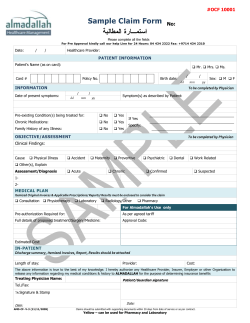
Strategies for a successful CDI program â our story
Strategies for a successful CDI program – our story April 10, 2015 What does a CDI program do? The purpose of a CDI program is to initiate concurrent and, as appropriate, retrospective reviews of inpatient records for conflicting, incomplete, or nonspecific provider documentation The goal of these reviews is to identify clinical indicators to ensure that the diagnoses and procedures are supported by ICD-9/ICD 10 codes. The primary method of clarification used by the CDI professional is electronic queries These efforts result in an improvement in documentation, coding, reimbursement, and severity of illness (SOI), risk of mortality (ROM) and value based purchasing initiatives 2 What do the experts say a CDI program should have? Tenured and respected RN’s who have years of clinical experience and excellent communication skills with providers A physician advisor Established Key Performance Indicators Excellent collaboration and communication with coding professionals Effective and easy to use software to enhance the CDI program A compliant CDI program with ongoing education and feedback An established structure to report on program success and opportunities for improvement 3 The Past Began in 2000 at St. Elizabeth Edgewood; added to Florence and Ft. Thomas when they merged with St. Elizabeth in 2010 The query process was paper based prior to the EPIC clinical documentation go live on May 15, 2012 The program was managed out of Quality Management and transitioned to Health Information Management in late 2012 Midas was the software tool used to track CDI progress The program did not have a formal Physician Advisor Key Performance Indicators were not published Success and performance was based upon financial impacts primarily Focused only on Medicare population 4 The Present Team consists of a CDI Team lead and 6.2 RN FTE’s for a total of 7.2 FTE’s Queries are electronically sent through the EPIC in-basket for physician response Transitioned from Midas to 3M CDIS in 2013 The program transitioned to Health Information Management in late 2012 and team was centralized under our coding division Iodine software implemented in October 2014 to assist with all payers being reviewed Physician Advisor hired in March 2015 Key Performance Indicators reported monthly Success and performance is based upon value based purchasing initiatives first and financial impacts second Educated CDI team on documentation guidelines to assist with value based purchasing in late 2014 Ongoing education for ICD 10 preparation 5 The Future Continued collaboration and education for value based purchasing and ICD 10 working with Coding, Patient Safety, Quality Management and Infection Control Continued evolution of Iodine software in terms of building alerts to assist with value based purchasing initiatives Continued expansion of Physician Advisor program to include 2 additional part time physician advisors Provide educational sessions to our providers in a collaborative effort with our Physician Advisor and other leaders Continued education of our CDI and Coding team regarding documentation guidelines to improve value based purchasing initiatives Continued education of our CDI and Coding team regarding documentation opportunities pre and post ICD 10 Exploration of computer assisted documentation tools for providers 6 KPI and process review Metrics were defined based upon benchmarks from AHIMA, ACIDIS and HFMA These results are calculated monthly and shared with the CDI, Coding, Physician Advisor and Revenue Cycle leadership This process assists us in telling our story over a period of time and making adjustments to our program as needed or as healthcare changes The premise behind a KPI tool is that you can’t improve or manage what you don’t track Review St. Elizabeth CDI KPI Review CDI process 7 Questions? 8 Contacts: Jon R. Kemper, RHIA Jon.Kemper@stelizabeth.com 859-301-2041 Jean Allen Ellington, RHIA JeanAllen.Ellington@stelizabeth.com 859-301-9190 9
© Copyright 2025













